 Research Article
Research Article
Prospects of Renewable Energy in Sudan
Osama Mohammed Elmardi Suleiman Khayal1* and Osam Ishag Suleiman2
1Department of Mechanical Engineering, Faculty of Engineering and Technology, Nile Valley University, Atbara, Sudan
2College of Energy and Power Engineering, Lanzhou University of Technology, Lanzhou, China
Osama Mohammed Elmardi Suleiman Khayal, Department of Mechanical Engineering, Faculty of Engineering and Technology, Nile Valley University,Atbara, Sudan.
Received Date: November 22, 2022; Published Date: December 13, 2022
Abstract
This paper reviews the prospects for renewable energy and sources in Sudan in relation to the current and potential situation in Sudan. There are many forms of environmentally friendly clean energy in Sudan which are represented in the solar, wind, hydropower, biomass, geothermal energies, and many others. In a country like Sudan with a favorable climate and vast areas, many forms of these sources are suitable to be utilized from the points of view of abundant agricultural fertile land, availability of water, plethora of minerals and wide space land which enable building and construction of renewable energy systems. These types of resources are viable choices for energy sustainability and development.
Keywords:Renewable energy; Prospective study; Availability of resources; Sudan
Introduction
Figure 1:The States of Sudan.
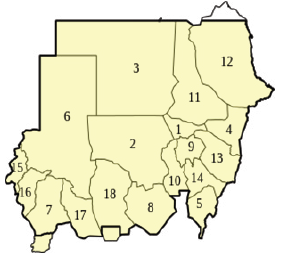
Figure 1 below shows the new map of the states of Sudan after secession of the South. Sudan has lost 60 percent of its biomass energy capacity, 75 percent of its oil reserves, and 25 percent of its hydropower capacity following the July 2011 secession of South Sudan. Owing to the declining stock of energy resources on one side and the increased population on the other side. This new expansion presents a crucial energy supply situation for all primary resources. The renewable energy generation which was not long ago a costly option will be subsidized developed governments to show an effort to transition to renewable energies, but nowadays these resources are also will be a new strategic asset for developing countries, as the universal industry is increasing faster and technology costs are falling down widely [1,2].
The potential is especially apparent in Sudan, where there are ample resources for geothermal, wind, hydro, solar, and biomass energies. As it becomes clear these energies have a significant purpose in several countries in the field of electrification process which includes short gird and out grid and still there are challenges remain when it comes to developing adequate regulations, attracting foreign investors. After describing the distribution of resources, this paper reviews all at the prospective of renewable energy in Sudan frameworks and possible ways of developing and setting targets in helping with this change [3].
The total size of Sudan’s land is 6 × 108 feddans, and the 18 states of Sudan are divided into four major categories of land use in the region. The potentiality of arable land is 8.4 × 106 ha, and the pastures are 29.94 × 106 ha, and the forests are 108.3 × 106 ha, and about 38.22 × 106 ha are used for other purposes. The total water supplies are 84 × 109 cubic meters. This includes the Nile River and its tributaries, and underground water which are measured at 26 × 1010 m3, of which only 1% is actually used. It is estimated that the total annual rainfall is 1093.2 × 109 m3 [4].
There are several kinds of sources that supply renewable energy, environmentally friendly energy (bioenergy) in Sudan like wind, solar, and hydropower. Many states in Sudan have a large space of rich land, a multitude of minerals, water, winds, and sunlight. Several types of these energies being a viable choice for renewable energy means sustainable energy like the sun that can’t run out or it’s infinite, also applies to green energy sources when you hear the word “alternative energy.” It means energy sources which are an alternative to non-sustainable sources that are more widely used [1,2].
Sudan is blessed with an immense renewable energy capacity that is still untapped. Poor infrastructure and daily power outages have been the focus of estimates of the power generation capacity of the electricity sector in Sudan. At present, the country’s electricity generation capacity consists of approximately 1700 megawatts of thermal power and approximately 1,600 megawatts of hydropower. The prospective for bioenergy is also high, particularly hopeful in the idiom of the geographical divide: while virtually anywhere in Sudan this type of energy could be harnessed, with different potential. Table 1 below shows renewable energy in Sudan.
Table 1:Renewable Energy in Sudan.
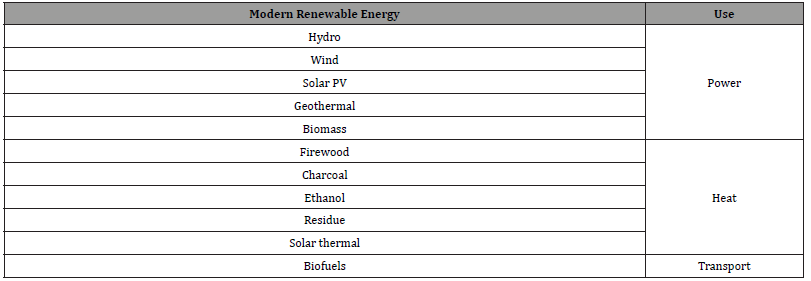
Source: Elaborated from (International Renewable Energy Agency 2015).
Speaking of modern clean energy means finding the direction of generating and consumption renewable energy that is pure and effective likely with present technology. Modern renewables can substitute or enhance Sudan’s conventional use of renewables. First and foremost, when it comes to the direct use of electricity from renewable energy sources in the production of electricity, the main issue is that wind and solar energy rely on a fluctuating source depending on wind speed and bright sunlight in order to make their contribution to power generation [3] (Table 2).
Table 2:Targets for renewables in selected States.

Some Sudanese states are embarking on highly ambitious projects in the field of renewable energy, such as the Northern State in Dongola and Northern Darfur in El Fasher, for Solar Power. And the Red Sea, Dongola, and Nyala, for Wind Power which are examples of clean energy in Sudan. Although the clean energy sector in most Sudanese states is far from mature, more states are setting clean energy targets today [5].
Over the past two decades, precipitation across the country has declined dramatically compared to that of 1971-2000, and this decline in precipitation has resulted in droughts threatening approximately 19 million hectares of rain fed and conventional mechanized farms. But in this decade, we are experiencing a rise in the rainfall rate at high rates, also causing floods in Sudan, so it is needed to exploit these rainfall rates in agriculture and energy production to tackle the outstanding problems of the Sudanese energy file. Biomass currently provides up to 61% of Sudan’s energy requirements. But it is also gradually providing increased production of electricity and biofuels for transportation. It is clear that the development of all forms of energy (thermal energy, electricity, transportation fuels and hydropower) from different forms of biomass from renewable and economically accessible sources in Sudan has space to increase [1].
Renewable energy projects have a good deployment record in Sudan, for example; solar pumping irrigation systems were used in off-grid Northern states, with the idea of replacing the diesel generators used in agricultural schemes. This project had been carried out by the UNDP, Sudan office, with a lifetime of 25 years and more than 1422 solar pump units that have begun implementation in 2015. There is also a bio-gas cook stoves project which have been implemented in the western states of Sudan to replace the less effective ordinary three-stone stoves (which have a significant negative effect on human health and the environment). The locally available animal waste has been chosen as a feedstock for the biogas units in the household [5].
The applications of the renewable energy revolution, the indicative goal of renewable energy efficiency representing the rate or value of savings in electricity consumed nowadays and up to 2030, was the product of steps to increase electricity efficiency and rationalization of electricity consumption. The technology could fully solve the problem of renewable energy, but the energy challenge is a multidisciplinary and multidimensional structural challenge [3].
Renewable Energy Resources in Sudan
Renewable energy is a clean energy, something that can’t run out or is infinite, like the sun when you hear the word alternate energy, generally referring to renewable energy sources. These sources of energy are alternatives to the non-sustainable sources that are most widely used. Hydropower, wind, solar, geothermal, and biogas energy are the renewable resource choices that match well with Sudan’s specific resource requirements and endowments. Figure 2 below shows the renewable energy sources. There are two main types of sources of renewable energy: traditional such as petroleum products and electricity and others, and non-conventional such as hydro, solar, and wind energy, and others. Sudan’s sunshine and the average wind speeds, hydropower, and biomass are comparatively high, The use of new and renewable sources of energy available in Sudan is now a key problem in the future strategic planning of an alternative to traditional fossil energy, in order to supply part of the local energy demand for an alternative to conventional fossil energy [4]. Figure 3 below shows renewable and nonrenewable sources of energy diagram. In the sense of renewable energy, Sudan is a significant case study because the country’s large variety of climates and ecosystems. Sudan has a well-defined commitment to continue research, development, and implementation of new technologies. Sustainable low-carbon energy scenarios for the new century emphasize the untapped potential of renewable resources. The rural areas of Sudan can benefit from this transition. The increased availability of reliable and efficient energy services stimulates new development alternatives. It is explained by a full-scale plan mostly for use in remote countryside areas. Hydropower energy and solar energy have been pursued on a wide scale in Sudan and the potential for the biogas energy, geothermal energy, and wind energy options is well known, but it has not yet been widely pursued [1].
Table 3:Annual Sugarcane Bagasse Available in Sudan.

The solar energy
Solar energy is the light and the heat coming from the sun. People can harness the energy of the Sun in a variety of different ways: photovoltaic cells that turn sunlight into electricity and thermal collectors that turn sunlight into heat. Figure 4 below shows a model of solar energy for generating electricity. Sudan has an exceptional source of solar energy that can be harnessed for the electrical generation and thermal applications. The desert areas in northern Sudan and some parts of southern and eastern Sudan in particular have long sunny days with a high intensity of radiation. Coastal and tropical conditions are also characterized by strong solar radiation. Solar energy can be used at different levels, making it suitable from the household and community level to industrial and national processing.
Figure 2:the renewable energy sources.
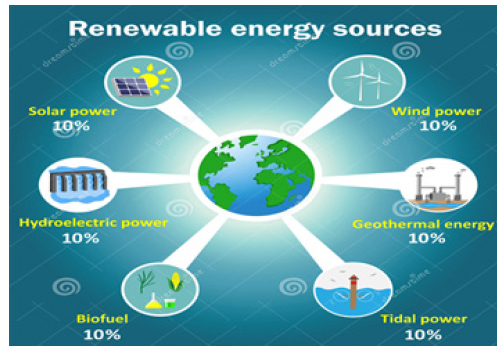
Figure 3:Renewable and Nonrenewable Sources of Energy Diagram.
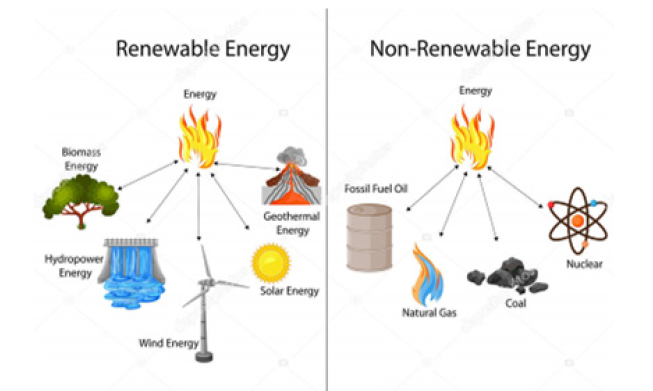
Figure 4:A Model of Solar Energy for Generating Electricity.
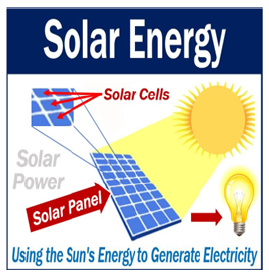
All possible uses of PV technologies are too numerous to include here, so only some of the most important uses, especially those that have been successfully demonstrated, have been listed. This includes the current addition of solar energy systems in certain states to the energy sector., such as using it in the state of North Darfur in Al-Fashir, with a capacity of five megawatts, to increase the electric power of the population of the state, and also in the state of Al-Jazirah, in Al-Bageir town, with a capacity of ten megawatts. In the northern state, it was used in more than one range, where it was used in electricity and in the countryside water pumping, road lighting, traffic signals in the city of Dongola, and many other uses. This is considered a successful model for using solar energy in Sudan. We hope to increase the capacities in Northern State, North Darfur, and North Kordofan and add other areas to sustain solar energy in Sudan [4]. Figure 5 below shows some of solar energy capacity in Sudan.
Figure 5:Some of Solar Energy Capacity in Sudan.
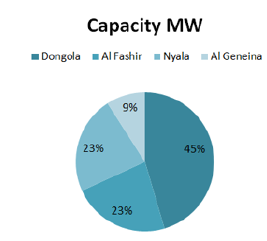
The wind energy
Wind energy (or wind power) means wind turbines which are used to capture kinetic energy for generating electricity, or the process of generating electricity by wind or air currents that exist naturally in the earth’s atmosphere. Figure 6 below shows a model of wind energy. In Sudan, wind energy is mainly used for water pumping. The wind has not yet been significantly exploited for power generation. Experience in wind energy in Sudan was started in the 1950s. Studies on wind resources in Sudan have demonstrated that wind power represents not only a relatively low-cost and reliable form of renewable energy but also contributes immensely to local employment, industrial development, and export benefits, particularly in the Northern region and along the Red Sea coast, some central states and in the hills of Jebel Marra in western Sudan wind conditions are very favorable for the electrical generation. The Sudanese government has recently begun to recognize the need to reintroduce the wind pumps technology, given the high and/or fluctuating oil prices, to reduce the country’s reliance on oil, and to help reduce the trade deficit. Due to the importance of wind energy Sudan has published a wind atlas in March 2012. Figure 7 below shows best wind speed zones in sudan. On the basis of this map, three areas with potential for hosting wind power projects have been identified, Jabel Marra Mountains in Western Sudan, Dongola town in Northern Sudan and the Red Sea region. Sudan is currently planning to build utility-scale wind farms in three regions, Dongola (100 MW) in the North, Nyala (20 MW) in the West and Red Sea (180 MW) in the East [4].
Figure 6:A Model of Wind Energy.
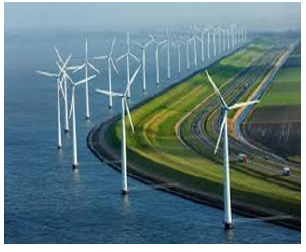
Figure 7:Best Wind Speed Zones in sudan.

The hydropower energy
Figure 8:A Model of Hydropower Energy.
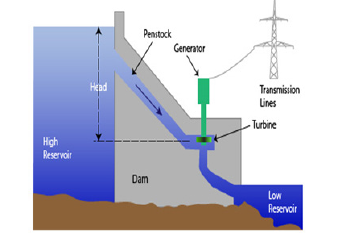
Hydro-electric energy is the cheapest electricity generation if the expense of the dam is not included in the cost of capital, (Sometimes dams, are constructed for irrigation, and may be used later as a hydro-electric power). Hydro-electric power is also considered to be the easiest in installation and operation with almost negligible operation and maintenance cost. Hydropower is a type of renewable energy using water stored in dams or flowing in rivers to produce electricity in hydropower plants. The falling water rotates a turbine’s blades, which then spins a generator which converts the spinning turbine’s mechanical energy into electric energy [6]. Figure 8 below shows a model of hydropower energy. A number of prospective areas have been identified by surveys and studies carried out to explore mini-hydropower resources in Sudan. The hydropower energy plants are categorized by their nominal capacity into one of four regimes: micro its capacity is 0 < 50 kW, and mini its capacity is 50 - 500 kW; small its capacity is 500 kW - 5 MW, and big its capacity is > 5 MW. Around 1 percent of the overall capacity of hydropower accounts for mini and micro-hydro which can be used in Sudan in two ways:
Using 1-100 m waterfalls; energy can be produced, and small power can be produced up to 100 kW. Using the current flow rate of the Nile water, it can be pumped to water farms on the riverside and run river turbines along the Blue Nile and the main Nile [7].
For the southern region, 3,785 MWh, and for the Jebel Marra region, and 44,895 MWh for the El Gezira and El Managel canals, the total mini-hydropower capacity is 67,000 MWh.Tiny hydro-plants (less than 5 MW) are more environmentally friendly than large hydro- projects, often involving major dams and a permanent transformation of the landscape.
There are more than 200 suitable sites in Sudan for the use of electricity for different states in some regions of Sudan, where there is a lot of rainfall and mountainous or hilly terrain, such as Jebel Marra. Some of the dams in Figure 9 below display the hydropower electricity production potential in Sudan [4].
Figure 9:capacity of Hydropower energy in Sudan.
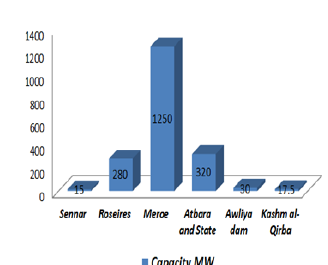
It should be noted that, unlike other renewables, hydropower and biomass rely on two important natural resources freshwater and biomass which in some areas of Sudan are increasingly required for numerous, and often conflicting uses through decreased precipitation, higher temperatures and desertification which are subject to climate change impacts. Innovative and maximizing development would require adapting to this fact.
The biomass energy
Biomass is solid organic, non- fossil material of biological origins. Biogas includes the principal methane and carbon dioxide produced by anaerobic digestion of biomass that is combusted to produce heat and power. liquid biofuels includes bio-based liquid fuel from biomass transformation, mainly used in transportation applications, and municipal waste produced by the residential, commercial and public services sectors incinerated in specific installations to produce heat and power. Figure 10 below shows the different biomass sources. Sudan has a vibrant co-generation industry, for an estimated combined capacity of 55.5 MW in sugar factories, primarily for its own use. With more advanced plant machinery, there are proposals to further expand co-generation in sugar production. Furthermore, proposals to use an agricultural pest, the Mesquite shrub, for household energy production are currently being developed; Sudan has an estimated 41.4 million hectares of forest resources, with a permissible cut of approximately 15.1 million cubic meters. Moreover, there is considerable potential for the use of agricultural residues, in particular crop residues and animal waste. The government also aims to add substantial production capacity for bioethanol and biodiesel in the coming years, 60 million liters per year and 50 million liters per year, respectively [5]. Table 3 below shows annual sugarcane bagasse available in Sudan.
Figure 10:Different Biomass Sources.
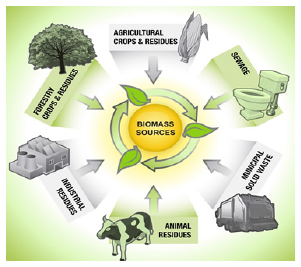
The geothermal energy
In the Earth, the basic geothermal energy is the sun. The word geothermal derives from the Greek terms geo (earth) and thermal (heat). Geothermal energy is a source of renewable energy since heat is generated continuously within the earth, People use geothermal heat for bathing, buildings for heating, and electricity generation [4] and [8]. Figure 11 below shows a model of geothermal energy. Geothermal energy in the coastal plain in Sudan represents the western edge of the Red Sea’s active tectonic structure. According to the ACRES (1992), for the several geothermal energy regions, significant potential has been reported:
Figure 11:A Model of Geothermal Energy.

• The area of Suakin which is about 100 to 170 km south of
Port Sudan. According to the National Energy Administration’s
(NAE).
• The Tagbo and Meidob Hills are located between 100 and
300 km northeast of Jebel a Meidob. On the Meidob hills, manifestations
of hot springs seem to be present, consisting of volcanic
flows that are classified as intermediate and their history
of the eruption is thought to be close to that of Jebel Meidob.
• Bayuda Volcanic Field is located about 200-350 km north
of Khartoum, near Merowe. First results of the geothermal potential
in the Bayuda area are still possible; indicating temperatures
of approximately 200 °C and further study research is required
to develop a reservoir model in order to provide power
for estimations.
• Jebel Marra Volcano. In terms of volcano-tectonic features
of Africa, the highest elevation in the Jebel Marra Mountains of
3042 m which is covering an area of approximately 8000 km2,
is strategically situated. It is known to be situated at a potential
triple junction in the African lithosphere.
The Renewable Energy Future in Sudan
As the population of Sudan rises, so does the demand for energy to homes, companies, and communities. Innovation and the expansion of renewable energy sources are key to maintaining sustainable energy levels and protecting our planet from climate change. Renewable energy sources contribute about 26 percent of the world’s electricity today, but its share is projected to hit 30 percent by 2024. According to the International Energy Agency (IEA), “This is a crucial moment for renewable energy,” said the IEA’s Executive Director, Sudan’s requirements for successful applications of renewable energy are attainable [1]. Figure 12 below shows a model map of expected future. However, the contribution of renewable energy systems to meeting the energy demand in Sudan is still very low, and the use of renewable energy is often absent in the primitive stages due to factors of sustainability and redundancy as Sudan’s energy policy has focused on ensuring energy supply, reliability, local sufficiency, timeliness, and economic stability. Some universities and research and management centers within the concerned ministries have begun to focus on developing renewable energies for their economic advancement and more competitive with other fossil fuels. Research and experiments have also tended to develop these sources. We hope Sudan will step up its efforts to use sustainable sources of energy and reduce its reliance on oil. A selection of renewable options suitable for Sudan’s environment is given by wind, solar, and biomass energy [9-17].
Figure 12:A Model Map of Expected Future.
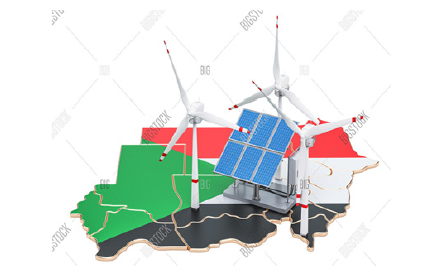
Conclusion
According to the study conducted in the field of renewable energy
and its sources throughout the country, the following were
proven:
• Sudan is fit to use clean energy of all kinds, because it has
a climate and nature suitable for all types of clean energy.
• The most types of clean energy used in a wide range in Sudan
are hydroelectric power (all water dams to generate electricity
and irrigation), solar energy (such as Northern State and
North Darfur) and little biomass energy (sugar factories).
• Wind energy and geothermal energy have been studied
and the locations of their sources in Sudan have been determined
such as wind and thermal power stations in the Red Sea
State, Jebel Marra, Nyala and Tagbo and Meidob Hills, but until
now it is not be fully implemented.
Recommendations
Increase the institutional plans relevant to renewable energy
systems through workshops to discuss the gradual conversion
to renewable energies.
• Encourage institutes and universities in research and
training on renewable energies. This action has many benefits
in different ways and contribute to the country’s economic development
and stability.
• Preparing field studies on the possibility of completing all
the previously studied projects and implementing them according
to the availability of potentials.
• Encourage the private sector in utilizing available renewable
energy sources that contribute in using these resources in
energy production and sustainability within the scope of our
country in renewable energy.
• Encourage countryside people to utilize clean energy
technologies instead of classic energy, also the government
must encourage clean energy systems in view of ecological benefits.
• Prepare field studies on the possibility of utilizing renewable
energies in the expected potential areas.
Acknowledgement
None.
Conflict of Interest
No conflict of interest.
References
- Saeed Tarig Mubarak (2020) Sustainable Energy Potential in Sudan. Journal of Engineering and Computer Science (JECS) 20(3): 1-10.
- Mubarak Saeed, Tarig, Bashier M Tayeb, Giddani Osman (2019) Sustainable Energy Potential in Sudan.
- Hafner Manfred, Simone Tagliapietra, Lucia de Strasser (2018) Prospects for renewable energy in Africa. Energy in Africa. Springer, Cham pp:47-75.
- Elzubeir AO (2016) Solar energy in Northern State (Sudan): current state and prospects. American Journal of Modern Energy 2(5): 31-37.
- Omer AM (2009) Sustainable energy: Challenges of implementing renewable technologies. Journal of Agricultural Biotechnology and Sustainable Development 1(1): 001-023.
- Elamin MEO (2006) Hydro-electric Power Technical and Economical (Doctoral dissertation, University of Khartoum).
- Omer AM (2007) Renewable energy resources for electricity generation in Sudan. Renewable and Sustainable Energy Reviews 11(7): 1481-1497.
- Khadam, Ashraf MA, Kamal Ramadan (2018) Geothermal Mainstream Adoption through Risk Mitigation in Sudan. International Conference on Computer, Control, Electrical, and Electronics Engineering (ICCCEEE). IEEE,
- Hood AH (2010) The Use of Liquefied Petroleum Gas (LPG) in Sudan.
- Panel IS, Ventura A (2007) United Nations Commission on Science and Technology for Development.
- Van Steenburgen F, Brouwer JH, Peters B, Plataroti L (2018) Country profile Sudan. Wageningen Centre for Development Innovation.
- Wind Energy Project.
- Fadlallah Sulaiman O, Djamal Eddine Benhadji Serradj (2020) Determination of the optimal solar photovoltaic (PV) system for Sudan. Solar Energy 208 : 800-813.
- Omer AM (2016) Agricultural residues for future energy option in Sudan: an analysis.
- Panel IS, Ventura A (2007) United Nations Commission on Science and Technology for Development.
- Demirel B, Gurdil GAK, Gadalla O (2019) BIOMASS ENERGY POTENTIAL FROM AGRICULTURAL PRODUCTION IN SUDAN.
- Elkadeem MR, Wang S, Sharshir SW, Atia EG (2019) Feasibility analysis and techno-economic design of grid-isolated hybrid renewable energy system for electrification of agriculture and irrigation area: A case study in Dongola, Sudan. Energy Conversion and Management 196: 1453-1478.
-
Osama Mohammed Elmardi Suleiman Khayal* and Osam Ishag Suleiman. Prospects of Renewable Energy in Sudan. Glob J Eng Sci. 10(4): 2022. GJES.MS.ID.000742.
-
Renewable energy, Prospective study, Availability of resources, Sudan
-

This work is licensed under a Creative Commons Attribution-NonCommercial 4.0 International License.






